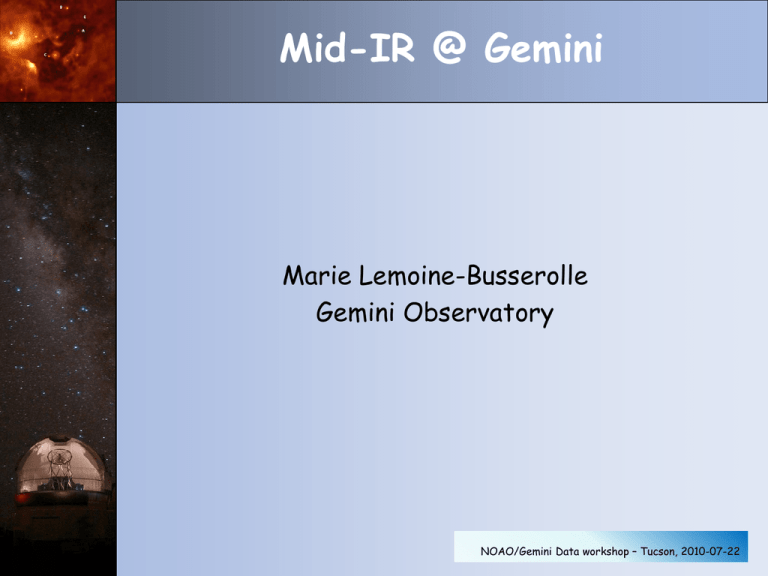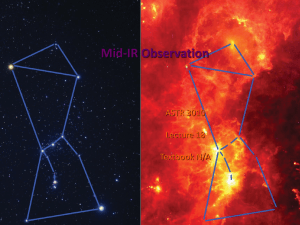Mid-IR @ Gemini Marie Lemoine-Busserolle Gemini Observatory NOAO/Gemini Data workshop – Tucson, 2010-07-22
advertisement

Mid-IR @ Gemini Marie Lemoine-Busserolle Gemini Observatory NOAO/Gemini Data workshop – Tucson, 2010-07-22 Overview • Part 1 : general intro to mid-IR Science • Part 2 : general intro to mid-IR observing • Part 3 : Imaging mode (Michelle) • Part 4 : Spectroscopy (Michelle) • Part 5 : example of Michelle data What is cool in the mid-IR? • Dust, basically. Absorbs visible light Emits in the IR (~blackbody spectrum with peak ~3000 m K) • Many obscured star forming regions only visible at 10 m and longer • Dust around accreting supermassive black holes emits strongly at 10 m • H2 in protostellar disks emits at 12 and 17 m --> test theories of planet formation What is cool in the mid-IR? Science in the Mid-IR Q: What can you study in the mid-infrared? A: Almost anything cold (100-300K) and/or dusty Star Formation Accretion Disks Extra-solar Planets Galactic Center Planetary Science Comet and Asteroids Dust in Galaxies Starburst Galaxies Supernova Remnants Planetary Nebulae Debris Disks Much, much more… Science in the mid-IR • Useful things in the mid-IR … – Broadband spectral energy distribution --> dust T & geometry – Many lines diagnostic of black hole & star formation activity, shocks, etc… 1 m 100 m • Fine structure lines • Aromatic + aliphatic hydrocarbons • Broad 10 + 20 m “silicate features” (Si-O bond stretch/bend) 5 m Starburst galaxies from Brandl et al. 2007 30 m • Atomic H and molecular H2 Diffraction-limited Observing The spatial resolution of a telescope of diameter D at a certain wavelength is given by: So in the visible, a 4-m telescope has the resolution: However we don’t ever get that resolution in the visible in reality because atmospheric seeing is ALWAYS much larger than that (seeing and resolution add in quadrature) Since “good” seeing is 0.25”, the visible is “seeing-limited” However in the mid-IR, a 4-m telescope has the resolution: We CAN get seeing better than (0.63x2=) 1.2” VISIBLE seeing regularly, so seeing does NOT normally affect Mid-IR observations So we say that the mid-IR is “diffraction-limited” Diffraction-limited Observing So in the visible, going from a 4-m telescope to a 8-m telescope does not gain you resolution (seeing-limited)! But, in the mid-IR you would gain a factor of two in resolution! Also, unlike the optical, one can regularly see “diffraction patterns” in mid-IR data. These patterns are not seen in the optical because they are smeared out by seeing Mid-IR Observing Reaps the Benefits of Large Aperture Telescopes Source Noise Dominated (optical) If 60min on a 4-m telescope, on a 10-m to achieve the same S/N only need ~10min - 6x faster Background Noise Dominated (mid-IR) If 60min on a 4-m telescope, on a 10-m to achieve the same S/N only need ~1.5min - 40x faster!!!! What is not cool in the mid-IR? Observing in the thermal infrared ( ≥ 5 m) presents special challenges to astronomers because the atmosphere, and any ground object in the field of view, typically radiates strongly and therefore introduces a large background. The background is often several orders of magnitude larger than the source signal in the N- and Qbands (10 and 20 m). What is not cool in the mid-IR? • 300 K blackbody peaks near 10 m (telescope + atmosphere) • H2O, CO2, O3, N2O, CH4 lines N band filters + atmospheric transmission Q band filters + atmospheric transmission T-ReCS Filters Wavelength (um) The Chop-Nod Technique The sky background is brighter and more variable in infrared: - At J,H,K sky is stable enough to get sky frame every ~60-120sec - At L (beginning to be background limited), stable over ~20sec - At M (a bit more background limited), stable for only ~10sec - At N, Q stable of only a fraction of a second (fully background limited) “Chopping” Refers to differencing the source frame and a nearby patch of sky This is done by moving the secondary mirror @1-50 Hz MAIN EFFECT: Removes thermal pattern of telescope and optics “Nodding” Refers to moving the whole telescope Performed once every 15-120 seconds MAIN EFFECT: Removes Sky Background The Chopping (or Wobbling) Secondary Chop 1 Chop 2 Detector Nod A Chop 1 Nod B Chop 2 Chop 1 Chop 2 = (Source + BGSky + BGTele,Chop1) – (BGSky + BGTele,Chop2) = (Source + BGSky + BGTele,Chop2) – (BGSky + BGTele,Chop1) = Source + (BGTele,Chop1 - BGTele,Chop2) = Source + (BGTele,Chop2 - BGTele,Chop1) Net Source Signal = SignalNodA + SignalNodB = Source + (BGTele,Chop1 - BGTele,Chop2) + Source + (BGTele,Chop2 - BGTele,Chop1) = 2 x Source Anatomy of a Michelle observation Repeat for ~40 sec, then nod whole telescope Time (sec) Move mirror to Expose (~100 ms); read position A out (~8 ms); repeat Move mirror to position B • Chop beams saved separately at end of every nod • Difference A-B also saved at end of every nod • File written at end of whole observation; has as many extensions as nods What you see in practice • MichX display tool • Raw data (chop A, no background subtraction) • The “diff”: Chop A - Chop B for a single nod • The “stack”: total signal, chop- and nod-subtracted • File only written on completion of whole observation – Can be tens of nods • Final file format: – N20090915S0001[N][320,240,M] – N nods – M = 1,2,3 (diff, chopA, chopB) Looking at data files • Files only written to disk at end of observation. • To display a single nod diff image/spectrum – cl> display N20090915S0001[1] • To display a single nod raw image/spectrum – cl> display N20090915S0001[1][*,*,2] • To display the final, stacked image/spectrum – cl> mireduce N20090915S0001 – cl> display rN20090915S0001[1] – Will see 1 positive and 2 negative images/spectra Michelle Imaging mode In the N and Q windows the sky/telescope background is so bright that we can only integrate for of order 50 ms before we fill up the detector wells. We have to continuously read out the detector as we observe. Michelle has a pixel size of 0.1 on the sky. The array is 320 by 240 pixels with 16 channels of size 20 by 240 pixels. There are 4 groups of 4 channels each. Imaging data example Nod 1 diff: 10” chop, 30 deg E of N Nod 1 diff Unguided beam is elongated (normal) Zoomed into guided beam, different z1, z2 Raw chopA, bad column, vignetting, no star visible. Taken in clouds, close to saturation Tight profile, diffraction ring, FWHM=0.34”, nice IQ Final, stacked data set N20090718S0064; an N = 1 mag (~15 Jy) standard star PSF Structure PSF Structure FWHM = 0.37at 11.7m Diffraction rings Imaging: data reduction guidelines • http://www.gemini.edu/sciops/instruments/mi dir-resources/data-reduction/imagingreduction • Iraf script: gemini, midir, midirexamples • http://www.iac.es/proyecto/blas-cabrera-gtcinstruments/media/cc_imaging_20070925.pdf NGC1068 as a case study • Unified model of active galactic nuclei (AGN) – All AGN powered by accreting SMBH – Look different because of orientation-dependent obscuration • Chemistry, geometry and origin of obscuration? Connection with galaxy evolution? NGC1068 as a case study • Torus emits strongly in MIR: SED and silicate feature constrain models of its physics and chemistry • Torus is only a few pc in diameter (<<0.1” in nearest galaxies) – can also have emission from radio jets, circumstellar shells, narrow line region… --> SPATIAL RESOLUTION! • NGC1068 is the “archetypal” type 2 AGN; relatively nearby at 14 Mpc; obvious candidate for N band spectroscopy Ground vs Space Gemini, VLT, Subaru, GTC… vs IRAS, ISO, Spitzer, Akari… • Issues to consider include * Sensitivity * Spatial resolution * Spectral resolution * Wavelength coverage Expense Upgrading/maintaining instrumentation • Airborne observatories like KAO, Sofia are somewhere in between Spatial resolution • Ground-based optical/NIR: seeing limited • Ground-based MIR: diffraction limited – 8m telescope /D approx 0.3” at 10 m – Spitzer ~3” at 10 m (80 cm telescope) – IRAS ~30” at 12 m Left: Gemini South/ T-ReCS 10.4 m Right: Spitzer/IRAC 8 m Sensitivity (I) • If we can subtract out the background emission, why worry about it? • Mean residual background level after chopping and nodding might be small, but rms not necessarily so • Dominant source of noise in MIR (usually) random fluctuations in number of background (sky + telescope) photons arriving on a pixel • Pixel-to-pixel variations in residual background then sqrt(raw background level) • If you’re looking for a faint source you want the background noise to be as low as possible; then your 2 smudge might be a 5 detection… Sensitivity (II) Q band atmospheric window Transmission N band atmospheric window Atmosphere is opaque; can’t observe 6 m Wavelength (microns) 28 m • Telluric lines (H2O, O3, CO2 , N2O, CH4…) mean increased background and decreased transmission • Also limit useful wavelength range • Variable transmission --> inaccurate flux calibration • Need a telluric standard star - close in time and space - to cancel atmospheric absorption lines Spectral resolution • Very high MIR spectral resolution (R> few thousand) not (yet) available from space • Pros of high resolution – More information! – Don’t have to chop! • Cons: – Lower sensitivity & -coverage – Spectral fringing • For NGC1068, you want to know about a broad feature (10 m Si-O bond stretch), so stick with low-res (R~200) Ground vs Space • In spite of the relatively low sensitivity and lack of wavelength coverage, we will observe from the ground at low spectral resolution because we need the spatial resolution • NGC1068 would saturate Spitzer anyway… (hah hah) The Observations (I) • NGC1068 N band spectra taken during commissioning of spectroscopy mode of Michelle on Gemini North Define acquisition procedure, grating, wavelength, slit, exposure time (before overheads!), chop distance and angle, guide stars… and same for telluric standard stars The Observations (II) • Use the OT library for phase !! One more point - careful standard star selection, Cohen standards useful but avoid late K and M spectral types (or model out SiO/silicate bands) Data Reduction (I) Spectral ChopB Diff (A-B) Spatial ChopA Filename[1][320,240,2] Filename[1][320,240,3] Filename[1][320,240,1] [1] signifies nod 1; 3 more images for every other nod (may have many tens), all in one file Line cut through chopA Line cut through sky in diff image Column cut through diff image Line cut through galaxy spectrum Data Reduction (I) • Check raw background level in individual nods Are any frames saturated? Clouds, high water vapour… • Check rms of residual background Are any frames unusually noisy? Random sky noise or “stripy” instrumental noise… • Do chop/nod subtraction --> single “stacked” file Final image has 1 +ve and 2 -ve spectra Can register target during stacking if bright and compact Data Reduction (II) • A few things we don’t need to do: • The detector bias chops out with the sky+telescope background • The dark current also chops out • To flatfield or not to flatfield? – MIR detectors fairly flat anyway – Unnecessary when science target and standard star on same row – With extended sources, experiment! Data Reduction (III) Spectral Extraction Real spatial information - extract spectra in steps along slit Size of steps depends on angular resolution (we used 0.4” steps, slit was 0.4” wide) Trace curvature of spectra across array? Not important for wide aperture extractions, is important here! Worth fitting and removing any background not removed by chop/nod procedure? Negative spectra not useful (unguided) Data Reduction (IV) • Wavelength calibration procedure is similar to optical/NIR – Identify calibration lines, fit, apply to science data • Except – No arc lines; use sky lines in raw data instead Data Reduction (V) • Divide galaxy spectra by standard star, multiply by blackbody curve Divide by standard Multiply by blackbody Atmospheric lines gone; spectrum much “smoother”; note strong rise to red Now see “true” galaxy spectrum; silicate feature and emission lines; messy at ends (atmosphere nearly opaque) also in O3 band Final Data Set Wavelength calibrated, flux calibrated 8-13 m spectra of NGC1068 from 2 different nights extracted in 0.4” steps along the slit, covering the nucleus and ionisation cones Results Radiative transfer modelling of Michelle nuclear spectrum and whole IR SED give torus parameters and intrinsic AGN luminosity Silicate feature strength measured in all spectra along slit reveals large, cold disk of material around the nucleus Spectra themselves reveal previously unknown complexity in emission lines, continuum shape and silicate feature profile on very small scales The finished product http://adsabs.harvard.edu/abs /2006ApJ...640..612M Papers based on Gemini mid-IR data • http://www.gemini.edu/sciops/instrume nts/midir-resources/midir-papers • “Characterization of the mid-IR image quality at Gemini South”. http://www.gemini.edu/sciops/instrume nts/miri/Li-Gemini-MIR-SPIEJune2010.pdf. • See Mason et al. 2008 (SPIE) “Observing Conditions and Mid-IR Data Quality”, also Westphal 1974. Advantages and Disadvantages of Mid-IR Observing Advantages Better Seeing (half of visible) Maximum use of telescope aperture (time to a given S/N goes as 1/D4) Diffraction-limited observing AO not necessary, or cheaper/easier Can observe when moon is up, bad light polluted sights, even during day Free sky, dark, and bias subtraction Time-series data: On the fly knowledge of data quality, clouds, can throw out image subsets Disadvantages Can’t observe through even thin cirrus - must be clear Need low water-vapor as well for 20um work A lot of overheads in the observing process Very-sensitive to mirror imperfections LowN and lowQ spectra Clockwise from top left: (1) Raw lowN spectrum, not chopping along the slit so only one spectral trace evident. (2) Line cut along lowN spectrum of standard star (note blue spectral shape). (3) Stacked lowN spectrum, beams not well balanced. (4) Raw lowQ spectrum, not chopping along slit, “gaps” are telluric water absorption lines MedN1, medN2 and echelle spectra • Characterised by strong fringing, esp. medN modes. Raw medN2 spectrum of NGC 1068. Note vertical sky lines and diagonal fringing. Bad channel is towards left of array, galaxy spectral trace is barely visible just below centre. Useful tools With spectroscopy we use the same process of chopping and nodding to remove the atmospheric contribution. The frame times can be somewhat longer than for imaging because we are spreading out the light from the slit over the entire detector, but we have to compromise between filling the detector wells and chopping/nodding fast enough to get a good atmospheric correction. At higher resolution one can use nod-only observations without difficulty, especially in cleaner parts of the N-band window. Raw Spectra Are Rather Ugly, Especially in Q-band.... Michelle Filter edge Second order begins O3 band T-ReCS BD+30°3639 Michelle spectrum Michelle Spectroscopic Modes: Name Wavelengths Dispers. Resolution Coverage lowN 7-14 0.024 200 7.7 lowQ 16-26 0.031 110 9.9 medium 7-26 0.0047 1000 1.5 high 7-26 0.0016 3000 0.5 echelle 7-26 30000 0.05 TEXES 5-25 ~100000 ~0.02 Wavelengths are in m, dispersions are in m/pixel, coverage values are in m. Things to look for in Michelle data A 1 Jy point source in N-band should be easily visible in the individual difference images for a nod. A source of some tens of Jy can be seen in the raw on-source image if one looks for it. At Q-band the background is about 3 times higher than at N-band so these values have to increase by roughly a factor of 3. A standard star of 5 to 7 Jy is quite bright enough for N-band imaging. If a standard is to be used at Q as well, it should be 15-20 Jy in brightness at N-band. This is also a good brightness for a low-N spectroscopy standard. Michelle raw image Line cut “staircasing” Since the last cool-down Michelle has a bad channel ~24000 ADU The “Hammer Effect” Raw stacked low-N spectrum Michelle noise (and removal of same) “Pin-stripe” noise Med N-1 spectral Raw Frame: Fringing Difference Frame of Standard Star Stacked Difference Spectrum Raw Med-N1 Spectrum: Fringing Residual Fringing Typical Spectral Cross-cut Pixel scale 0.2 Chop Tails--A Problem With the Michelle PSF Fair Seeing PSF Poorer Seeing PSF




